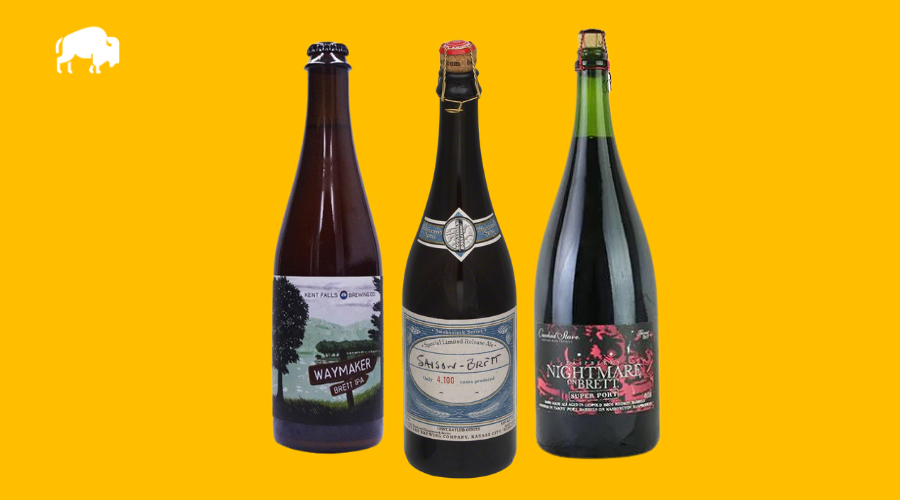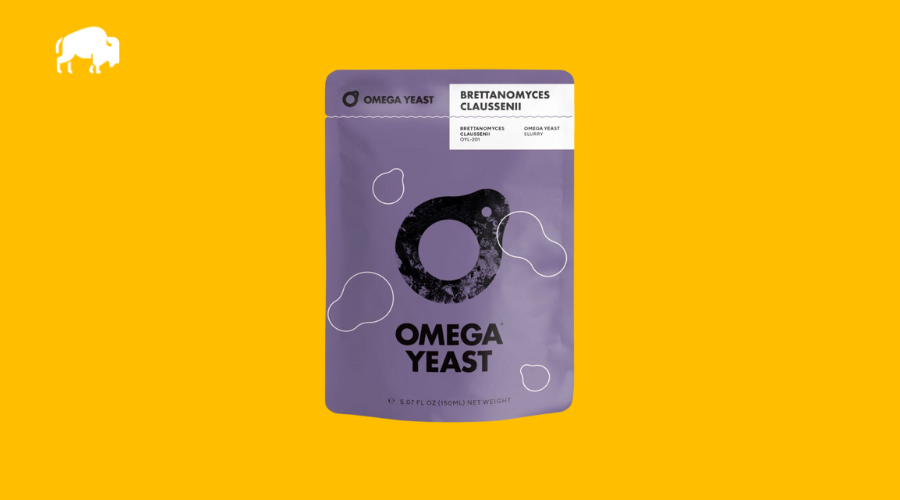Brett beer saw a rise in popularity throughout the 2010s in the United States. Beers like Goose Island’s Matilda and Boulevard’s Saison Brett introduced this funky yeast to craft beer drinkers across the country.
Homebrewers quickly jumped on board. They spread methods, techniques, and wild yeast strains to hobbyists and professionals alike!

Want to learn how to brew your own Brett beer? Follow our guide to learn more about brewing with Brett and make our 100% Brett pale ale recipe.
What is a Brett Beer?
Brettanomyces – Brett for short – is a wild yeast used in brewing that is typically considered a spoilage microbe. It differs from typical brewer’s yeast (Saccharomyces or Sacch) with its unique and funky characteristics.
Brett beer is a beer that is fermented with this Brettanomyces yeast. These beers have a specific aroma, flavor, and mouthfeel that is distinctly… Brett-y. When you drink Brett beer, it’s immediately apparent that it’s been fermented with Brettanomyces. There’s really no mistaking the flavor.
Brett has a slower growth rate than Sacch, meaning it usually takes much longer for the yeast to finish fermenting. It slowly chews through all of a beer’s fermentable sugars. During this time, a beer’s character changes and evolves, usually becoming funkier and funkier.
Although Brett is often considered an off-flavor in beer, the yeast produces unique and complex flavors. Because of this, creative brewers harness Brett to create delicious concoctions.
Traditionally, Brett is used in combination with brewers yeast to add funkiness and complexity to a range of beer styles. More recently, brewers have used it for 100% Brett fermentations.
Belgian lambic and American sour beers are fermented with a blend of yeast and bacteria, including Brett. These sour-forward styles are typically not considered “Brett beer,” as Brett is not front and center but plays a supporting role.
What makes a good Brett Beer?

Nearly any beer style can be fermented with Brett. The characteristic Brett funk adds complexity, highlighted by a mix of tropical and stone fruit, leather, and smoky phenols.
A great Brett beer should exhibit these characteristics, but the wild yeast should work harmoniously with other flavors.
Brett bombs – as they’re known – are beers where the Brett becomes overpowering and one-dimensional. The best Brett beers contain the wild yeast flavor and use it to lift up other aspects of a beer.
Great examples of Brett beer range from slight barnyard funkiness to highly fruity. Depending on the strain of Brett and the base style of beer, the combinations are endless.
How to Brew a Brett Beer
Brett beer is brewed just like any other beer. In fact, you can add (or replace) a Brett yeast to most recipes, and you’ll have brewed a “Brett beer.”
When brewing with Brett, the primary considerations are yeast selection, fermentation, and cold-side handling.
Let’s look at how to brew the absolute best beer using Brett.
Handling Brett to Avoid Contaminating Brewing Equipment
Before we get into recipe design, let’s first touch on equipment. Brett is known to be hard to fully clean off cold-side brewing equipment. And it only takes a tiny amount of Brett to contaminate a batch of clean (Sacch) beer.
Many brewers use separate cold-side equipment for every piece that touches Brett. We recommend following this strategy for plastic components (like hoses and plastic fermenters). For stainless steel and glass equipment, thorough cleaning practices are enough to safely clean Brett.
At the end of the day, it’s your decision how to handle your brewery. If you use the same equipment for Brett and Sacch beers, pay extra attention to cleaning and sanitizing. You may have a Brett cross-contamination if you notice “clean” beers attenuating more than expected, bottle gushers, or funkiness. Keep in mind that Brett works slowly. You may only see a change in character over the course of a few months.
Brett Yeast Selection
Just like typical brewer’s yeast, there are many strains of Brett. Each strain uniquely expresses itself, but they generally all have that quintessential Brett funk.

Here are a few of our favorite, readily available Brett strains:
| Strain | Characteristics | Yeast Lab Options |
|---|---|---|
| Brett bruxellensis | A classic Brett funk, with distinct earthiness and round fruitiness. |
|
| Brett claussenii | Mild funkiness highlighted by tropical fruit, pineapple, and cherry pie filling. |
|
| Brett lambicus | Distinct barnyard funkiness and stone fruit character. |
|
Brett Pitch Rate and Fermentation Temperature
There are a few ways to use Brett in your fermentations. Choosing when and how much to pitch is the first consideration. After that, the magic of fermentation needs to do its thing. Brett beer tends to evolve over time both in the fermenter and in the bottle/keg.
100% Brett Fermentation
We recommend a high pitch rate when brewing 100% Brett beers, like Brett IPA or Brett Pale Ale. A good rule of thumb is to pitch 100% Brett fermentations with a higher rate than typical ale yeasts but not as high as lager strains. That means a pitch rate of at least 1.2 x 107 cells/mL. Use a healthy starter to build up Brett as needed.
100% Brett fermentation works best at ale temperatures (68-72°F). This range promotes efficient fermentation and Brett fruitiness. These beers usually take about 2 to 3 weeks to reach their final gravity. Unlike mixed-fermentation Brett beers, 100% Brett fermentation generally doesn’t finish as dry. A final gravity of 1.005 to 1.015 is not uncommon for 100% Brett beer.
Co-pitching Brett and Sacch Yeast
Pitching Brett and Sacch simultaneously is common for making beers like American Brett saison and farmhouse ales.
Co-pitching allows the Sacch and Brett strains to contribute unique flavors. Generally, the Sacch strain will help ferment the beer quickly with the expected profile and performance of the chosen strain. Brett works in the background, slowly but surely. When the Sacch is fermented, Brett is happy to continue consuming the remaining long-chain sugars.
The result is a funky hybrid that can be consumed relatively young (3 to 6 months) with distinct Brett notes.
Co-pitching only requires a small pitch of Brett yeast. For a 5-gallon batch, pitching one vial of a White Labs Brett strain (about 200,000 cells/mL) is sufficient for this purpose. Pitch this along with a healthy starter of the Sacch stain.
Brett Secondary Fermentation
Adding Brettanomyces to secondary fermentation is an excellent option for complex Brett expression. Typical brewer’s yeast (like a saison strain, for example) is used for primary fermentation. Brett is added to consume any remaining sugars over time when the beer reaches its final gravity.
Since Brett works slowly, this method requires time. Let the secondary fermentation occur for at least 4 to 12 months. You can monitor the beer’s character over this time. The Brett flavor and aroma will also continue to evolve once packaged.
For secondary fermentation with Brett, you only need a small pitch of Brett yeast. For a 5-gallon batch, like with co-pitching, one vial of a White Labs Brett strain will be plenty.
Bottling with Brett
Bottling with Brett can be tricky and should be approached with caution. Brett will ferment all of the sugars in a beer. If you add Brett to a beer with any residual sugar (a final gravity higher than 1.000), expect high carbonation. And, of course, with high carbonation, there is a risk of gushing bottles or even bottle bombs.
Adding Brett at bottling takes experimentation. You can assume that the Brett will bring the final gravity down to 1.000 once in the bottle. For that reason, you should not use much (if any) priming sugar, depending on the beer’s final gravity after the primary fermentation.
Some brewers use a highly attenuative Sacch yeast (like WY3711) to get the beer down to 1.000 before bottle conditioning. This will provide more predictable carbonation, but the Brett character will be muted as there are fewer complex sugars for the Brett to eat.
Grain Bill for Brett Beers
Most strains of Brettanomyces are capable of chewing their way through all types of sugars in beer fermentation. Even long-chain sugars that typical brewers yeast does not consume, Brett is happy to slowly eat them away.
Even with low final gravity, higher protein grains like wheat, rye, oats, and spelt can help boost the beer’s body.
It’s also a great idea to mash on the high side, around 155°F to 159°F. This will create more long-chain sugars, giving Brett plenty of food to slowly consume.
Brett Beer Tips
Beer Style Ideas
Here are some great styles to brew with Brett:
- Hoppy Brett beer: IPAs and pale ales fermented with 100% Brett are deliciously tropical and funky.
- Brett kettle sour: Fermenting a kettle sour with Brett adds funky complexity to a sour beer base. This technique can mimic traditional Belgian sours and contemporary American wild ales.
- Brett saison: Many Saccharomyces saison yeast strains already provide funkiness and earthiness. Paired with Brett, barnyard flavors are highlighted and amplified.
- Brett Stout or Porter: Darker beers are also great candidates for Brett. Fruity Brett strains accent dark fruit flavors from styles like Stout and Porter.
Bottle Conditioning Brett Beer
Brett beers really flourish when naturally carbonated. Even for hoppy beers, bottle or keg conditioning creates outstanding results. Brett is known to consume oxygen, helping to protect the beer once packaged.
I’ve had great results in bottle conditioning 100% Brett IPA. Where a comparable Sacch IPA would have oxidized quickly, a Brett IPA has a longer shelf life. The Brett scavenges oxygen to keep the fruity hop character fresh and vibrant.
Brett Pellicle
Brettanomyces fermentations may (or may not) form a pellicle on the beer’s surface. It might look like the surface of a faraway planet right inside your fermenter! This is entirely normal.

Don’t try to remove the pellicle. It might fall before packaging – or might not. If it persists, you can safely rack the beer from below the pellicle when transferring it to the bottling bucket or keg.
You may also see a tiny pellicle forming on the beer’s surface inside the bottles. This is also normal and safe to drink.
Farmhouse Brett Pale Ale Recipe
Combining Brett and hops creates unique and unexpected flavors. Pairing specific Brett strains with choice tropical hop varieties makes for excellent pale ales and IPAs.
Brett C has characteristic cherry notes that are hard to find in hops. This unique melange is a funky fruit cup, complemented with some Hallertau Blanc and Mosaic! Using some rye and spelled malt adds a rustic graininess and contributes to a full, structured body.
| Final Volume | OG | Final Gravity | ABV | IBU | SRM |
|---|---|---|---|---|---|
| 5 Gallons | 1.052 | 1.010 | 5.4% | ~32 | 4 |
Fermentables
| Amount | Type | PPG | °L | Grist % |
|---|---|---|---|---|
| 8 lb | 2-Row Malt | 37 | 1.8 | 80% |
| 1 lb | Rye Malt | 36 | 3.7 | 10% |
| 1 lb | Spelt Malt | 37 | 2.0 | 10% |
| 10 lb |
Hops
Amount | Variety | AA | Use | Time | IBU |
|---|---|---|---|---|---|
| 1.5 oz | Hallertau Blanc | 10% | Boil | 60 min | 20 |
1.5 oz | Hallertau Blanc | 10% | Whirlpool | 15 min | ~7 |
| 1 oz | Mosaic | 12.5% | Whirlpool | 15 min | ~5 |
1 oz | Hallertau Blanc | 10% | Dry hop | 3 days | – |
| 1 oz | Mosaic | 12.5% | Dry hop | 3 days | – |
Yeast
WLP645 Brettanomyces claussenii
Step 0 – Yeast Starter
- A week before brew day, make a yeast starter. Build up the starter to about 2 to 2.5 liters for a pitch rate of at least 1.2 x 107 cells/mL.
Step 1 – Mash
- Mash with a single infusion rest at 156°F for 60 minutes. Sparge the total volume into the kettle.
Step 2 – Boil
- Bring the wort to a boil.
- Add 60-minute hop addition.
- Turn off the heat.
- Chill wort to 170°F.
- Add whirlpool hops and steep for 15 minutes.
- Chill wort to 68°F.
- Transfer cooled wort to a sanitized fermenter, leaving trub and hop matter behind.
- Oxygenate wort and pitch the Brett.
Step 3 – Fermentation and Dry Hop
- Ferment at 70°F.
- Add dry hops 3 days before packaging.
Step 4 – Packaging
- Packaged beer and carbonate to 2.5 to 2.7 volumes of CO2.
- Allow carbonated beer to condition for 1 to 2 weeks.
Final Thoughts
Many people think Brett beer is a strange or acquired taste – but there’s a flavor out there for everyone. To pale ales, IPAs, saisons, and stouts… Brett adds funkiness, fruitiness, and complexity.
Brewing Brett beer at home can test your patience when co-pitching and for secondary fermentations. It can also be quickly rewarding brewing with 100% Brett.
Whichever way you brew your Brett beer, keep a few bottles around for long-term aging. Part of Brett’s fun is witnessing the unique taste evolution of these fascinating wild yeast strains!

